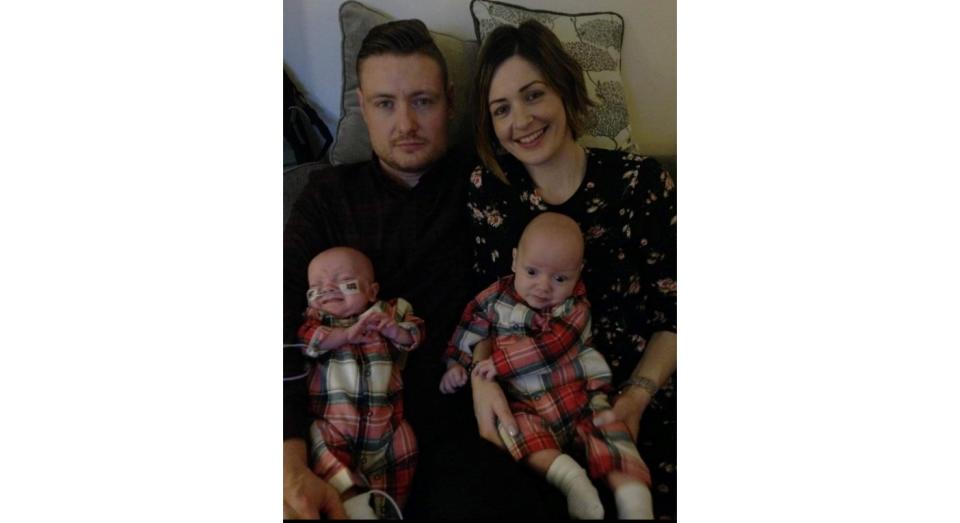One identical twin born almost double the size of the other due to rare condition
A pair of identical twins were completely different sizes when they were born due a rare, life threatening condition.
A prenatal scan at 23 weeks revealed that Emmett and Sebastian Murphy had Twin to Twin Transfusion Syndrome (TTTS) - where identical twins share a placenta unequally.
When they were born, Sebastien was almost double the size of his brother due to the condition.
Read more: Helplessness, loneliness and grief - How men are impacted by miscarriage
Sebastian was getting too much blood and nutrients in the womb, while tiny Emmett wasn't getting enough - a potentially fatal situation for them both.
Doctors warned worried parents Lauren Murphy, 34, and dad James, 38, that without treatment, there was less than 10% chance of survival.

More than two months before their due date, Lauren underwent an emergency c-section in a bid to save the twins. Sebastian, who was born weighing 3lb was almost twice the size of Emmett - who was born weighing just 1lb 9oz.
After 25 blood transfusions and fighting off sepsis three times, Emmett was finally able to come home and be reunited with his twin - seven months after his birth.
Lauren, a manager for The Body Shop, from Halesowen, Birmingham, said: “I was in complete shock when I first saw the twins in the neonatal unit after being born - they looked so different.
"They were both so small, but especially Emmett - he looked like a foetus instead of a baby.
Read more: Emma Roberts reveals she froze her eggs after fertility struggle
"I hadn’t realised quite how poorly they were until that moment. I remember thinking 'how can a baby have that many wires attached to them'?
“I think it really hit me when the doctor told me ‘there are 40-something babies on the unit and yours are the most sick’.
“We had barely even heard of Twin to Twin Transfusion Syndrome - and suddenly we were at risk of losing one or both of our boys because of it.”
Lauren and James, an insurance trader, were over the moon when they first learned she was pregnant with twins, due in August 2016.

Already parents to three children - Jack, 11, Abby, seven, and Matilda, five - doctors later warned Lauren and James that their twins were sharing a placenta, increasing the chance of complications.
A 23-week scan revealed one of the twins, Emmett, seemed to have stopped growing, while Sebastian seemed to be growing very quickly. They were diagnosed with TTTS which occurs when blood passes from one twin, the donor, to the other twin, the recipient, through the placenta.
Professor Mark Kilby, a consultant in fetal medicine at Birmingham Women’s Hospital, said this causes an imbalance in blood pressure between the twins in-utero.
He said left untreated, the chance of surviving is less than 10%, and with treatment, the chance of both twins surviving is still only 60%.
Read more: How Chrissy Teigen is talking to Luna and Miles about their brother Jack
Lauren said: “They told us we were at high risk of losing both the boys, especially Emmett."
Concerned doctors were monitoring the twins’ progress with regular scans - and every scan showed Sebastian growing larger as Emmett became weaker.
On 9 June, 2016, still more than two months from the boys’ due date, Lauren went for a scan and the doctor told her that they couldn’t find Emmett’s heartbeat.
She said: “We were told I needed an emergency caesarean section there and then to try and save the babies. I had no idea what was going to happen.
“I had to call my mum to bring an overnight bag for me. We hadn’t been expecting the boys for more than 11 weeks yet.”
Within three hours, the twins were delivered by c-section and rushed to the neonatal intensive care unit (NICU). Hours later Lauren and James were finally able to see the babies and were shocked to see that their ‘identical’ twins looked nothing alike.

After 13 weeks, Sebastian’s condition stabilised and he could come home - but tiny Emmett remained in critical condition.
Lauren said: “I was hysterical bringing Sebastian home - while I was thrilled he was doing well, it upset me that I couldn’t bring the boys home together.
“We had no choice, but it felt like we’d left Emmett all by himself away from his family.”
Emmett spent three more weeks in NICU before being transferred to the high dependency unit at Birmingham Children’s Hospital.
Lauren said: "At one point we were told he wouldn’t survive the night, and we should consider switching off his machine. He really was that sick."
Read more: Children as young as 11 are being prescribed nicotine patches by the NHS
But in January 2017, Emmett finally started to improve.
“Some of the nurses told me they’d never seen such a sick baby pull through,” Lauren recalled. "They told us he was a miracle.”
The family were finally able to bring Emmett home later that month - and for only the second time ever, the family were all in the same room together.
Lauren said: “That was an incredible feeling, properly bringing all of the family together. Bringing Emmett home and reuniting him and Sebastian after so long was amazing.”
Now aged four, the twins started school in September. They both have lasting medical conditions but “never let anything stand in their way in life” their mum said. Emmett has cerebral palsy and Sebastian has some behavioural difficulties.
Lauren said: “They both love going to school and they seem to be doing really well and have settled in nicely.
“I have to give all the credit to Birmingham Children’s and Women’s hospitals for all the support they showed us and the boys during those months. We’ll be forever grateful for what they’ve done for our family.”
Watch: 5 tips to boost your mental health


